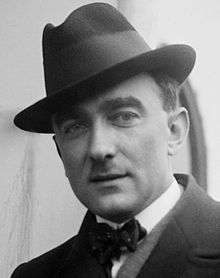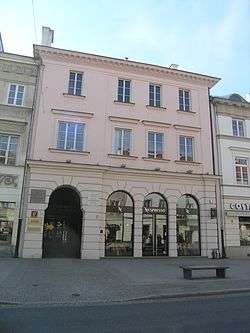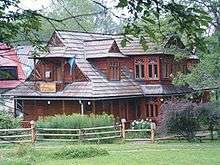Karol Szymanowski
Karol Maciej Szymanowski (Polish pronunciation: [ˌkarɔl ˌmat͡ɕɛj ʂɨmaˈnɔfskʲi]; 6 October 1882 – 29 March 1937)[1] was a Polish composer and pianist, the most celebrated Polish composer of the early 20th century. He is considered a member of the late 19th-/early 20th-century modernist movement Young Poland and widely viewed as one of the greatest Polish composers.

The early works show the influence of the late Romantic German school as well as the early works of Alexander Scriabin, as exemplified by his Étude Op. 4 No. 3 and his first two symphonies. Later, he developed an impressionistic and partially atonal style, represented by such works as the Third Symphony and his Violin Concerto No. 1. His third period was influenced by the folk music of the Polish Górale people, including the ballet Harnasie, the Fourth Symphony, and his sets of Mazurkas for piano. Król Roger composed between 1918 and 1924, remains the most popular opera by Szymanowski. His other significant works include opera Hagith, Symphony No. 2, The Love Songs of Hafiz, and Stabat Mater.
He was awarded the highest national honors, including the Officer's Cross of the Order of Polonia Restituta, the Order of Merit of the Republic of Poland and other distinctions, both Polish and foreign.[2]
Life

Szymanowski was born into the Korwin-Szymanowski family, members of the wealthy land-owning Polish gentry class, in the village of Tymoszówka, then in the Kiev Governorate of the Russian Empire (now Tymoshivka in Cherkasy Oblast, Ukraine). He studied music privately with his father before enrolling at the Gustav Neuhaus Elisavetgrad School of Music in 1892. From 1901 he attended the State Conservatory in Warsaw, of which he was later director from 1926 until retiring in 1930. Since musical opportunities in Congress Poland were quite limited, he travelled throughout Europe, North Africa, the Middle East, and the United States. In Berlin he founded the Young Polish Composers’ Publishing Company (1905–12) whose primary aim was to publish new works by his countrymen. During his stay in Vienna (1911-1914) he wrote the opera Hagith and composed two song cycles called The Love Songs of Hafiz, which represent a transition between the first and second periods of the composer's style. Being lame in one knee made him unsuitable for military service in World War I, and consequently, between 1914 and 1917, he composed many works and devoted himself to studying Islamic culture, ancient Greek drama as well as philosophy. During this period, his works such as Mity (1914; “Myths”), Metopy (1915; Métopes), and Maski (1916; “Masques”), are characterized by great originality and diversity of style. The dynamic extremes in Szymanowski's music became softened, and the composer started employing coloristic orchestration and using polytonal and atonal material while preserving the expressive melodic style of his previous works.[1]
In 1918, Szymanowski completed the manuscript of a two-volume novel, Efebos, which took homosexuality as its subject.[3][4] His travels, especially those to the Mediterranean area, provided him with new experience, both personal and artistic. Arthur Rubinstein found Szymanowski different when they met in Paris in 1921: "Karol had changed; I had already begun to be aware of it before the war when a wealthy friend and admirer of his invited him twice to visit Sicily. After his return he raved about Sicily, especially Taormina. 'There,' he said, 'I saw a few young men bathing who could be models for Antinous. I couldn't take my eyes off them.' Now he was a confirmed homosexual. He told me all this with burning eyes."[5]
Of his works created or first imagined, such as Król Roger, during the years 1917 to 1921, both musical and literary, one critic has written: "we have a body of work representing a dazzling personal synthesis of cultural references, crossing the boundaries of nation, race and gender to form an affirmative belief in an international society of the future based on the artistic freedom granted by Eros."[3]
Szymanowski settled in Warsaw in 1919. In 1926 he accepted the position of Director of the Warsaw Conservatory though he had little administrative experience. He became seriously ill in 1928 and temporarily lost his post. He was diagnosed with an acute form of tuberculosis, and in 1929 traveled to Davos, Switzerland, for medical treatment. Szymanowski resumed his position at the Conservatory in 1930, but the school was closed two years later by a ministerial decision. He moved to Villa Atma in Zakopane where he composed fervently. While living in Zakopane, Szymanowski developed a keen interest in the Polish folk idiom and undertook the task of creating a Polish national style, an endeavour not attempted since the times of Chopin. He immersed himself in the culture of the Polish Highlanders (Gorals) and embraced their tonal language, syncopated rhythms, and winding melodies into the new style of his music.[1] In 1936 Szymanowski received more treatment at a sanatorium in Grasse, but it was no longer effective. He died at a sanatorium in Lausanne on 29 March 1937. His body was brought back to Poland by his sister Stanisława and laid to rest at Skałka in Kraków, the "national Panthéon" for the most distinguished Poles.[2]
Szymanowski's long correspondence with the pianist Jan Smeterlin, who was a significant champion of his piano works, was published in 1969.[6]
Influences
Szymanowski was influenced by the music of Richard Wagner, Richard Strauss, Max Reger, Alexander Scriabin and the impressionism of Claude Debussy, and Maurice Ravel. He also drew much influence from his countryman Frédéric Chopin and from Polish folk music. Like Chopin he wrote a number of mazurkas for piano. He was specifically influenced by the folk music of the Polish Highlanders, which he discovered in Zakopane in the southern Tatra highlands. He wrote in an article entitled "About Goral Music" : "My discovery of the essential beauty of Goral music, dance and architecture is a very personal one; much of this beauty I have absorbed into my innermost soul" (p. 97). According to Jim Samson (1977, p. 200), it is "played on two fiddles and a string bass," and, "has uniquely 'exotic' characteristics, highly dissonant and with fascinating heterophonic effects." Carefully digesting all these elements, eventually Szymanowski developed a highly individual rhapsodic style and a harmonic world of his own.
Aleksander Laskowski describes the composer's music and its changing style in the following words: “He invented a musical language [...] His works were true and ingenious creations. And his oeuvre shows an incredible development from the Straussian and Wagnerian, through an interesting and very romantic Oriental period, and finishing with a national period influenced by his time in the Tatras.”[7]
Works

Among Szymanowski's better known orchestral works are four symphonies (including No. 3, Song of the Night with choir and vocal soloists, and No. 4, Symphonie Concertante, with piano concertante) and two violin concertos. His stage works include the ballets Harnasie and Mandragora and the operas Hagith and King Roger. He wrote much piano music, including the four Études, Op. 4 (of which No. 3 was once his single most popular piece), many mazurkas and Métopes. Other works include the Three Myths for violin and piano, Nocturne and Tarantella, two string quartets, a sonata for violin and piano, a number of orchestral songs (some to texts by Hafiz and James Joyce) and his Stabat Mater.
According to Samson (p. 131), "Szymanowski adopted no thorough-going alternatives to tonal organization [...] the harmonic tensions and relaxations and the melodic phraseology have clear origins in tonal procedure, but [...] an underpinning tonal framework has been almost or completely dissolved away."
Szymanowski's music has received international recognition. In the 1920s and the 1930s, his music proved immensely popular. The composer's works were performed throughout the world by celebrated soloists such as Artur Rubinstein, Harry Neuhaus, Robert Casadesus, Paweł Kochański, Bronisław Huberman, Joseph Szigeti, and Jacques Thibaud and by orchestras led by famous conductors including Emil Młynarski, Albert Coates, Pierre Monteux, Philippe Gaubert, Leopold Stokowski, Willem Mengelberg. European and American performances of his Stabat Mater were world-scale events, progressing successfully in Naples, Paris, Liege, New York, Chicago and Worcester. A performance of King Roger in Prague on 21 October 1932 directed by Josef Munclingr closely reflected the composer’s own idea of the piece, and turned out a huge success, just as the stage production of Harnasie. A Polish recording of his Symphony No. 4 (“Symphonie Concertante”) in 1932 was followed by a series of performances abroad, mostly with Szymanowski at the piano and conducted by Grzegorz Fitelberg. In 1933, the symphony was performed in London, Bologna, Cleveland; Moscow, Zagreb, Bucharest; in 1934 – in Paris, Sofia, London; in 1935 – in Stockholm, Oslo, Bergen, Berlin, Rome, Liege and Maastricht; in 1937 – in the Hague.[8]
In 1994, a renowned director Charles Dutoit recorded both of his Violin Concertos with Montreal Symphony Orchestra.[9] English conductor, Sir Simon Rattle, called him “one of the greatest composers of this [20th] century” and produced a series of important recordings with the Birmingham Symphony Orchestra. In 2004, Scottish violinist Nicola Benedetti won the BBC Young Musician of the Year with a performance of Szymanowski’s Violin Concerto No. 1. In 2008 his opera King Roger, which is regarded as his masterpiece, was performed at Edinburgh International Festival under the baton of Valery Gergiev and his renowned Mariinsky opera company. In 2012 Gergiev led the London Symphony Orchestra's performance of all four of the composer’s symphonies at the Edinburgh International Festival.[7] In 2015 opera King Roger was staged in London's Royal Opera House and was produced by Kasper Holten.[10] In the past two decades, his music has enjoyed a great revival and has been performed around the world. It has been recorded by many prominent conductors and musicians such as Pierre Boulez, Edward Gardner, Vladimir Jurowski, Mark Elder and Krystian Zimerman.[11]
Recognition
Karol Szymanowski received numerous important awards, which include: The Officer Cross of the Order of Polonia Restituta; The Officer of the Order of the Crown of Italy; The Commander of the Order of the Crown of Italy; the Knight of Legion d'Honneur; an honorary plaque at the Accademia Nazionale di Santa Cecilia; The Commander Cross of the Order of Polonia Restituta; The Academic Golden Laurel of the Polish Academy of Literature, Order of Merit of the Republic of Poland. He was also a Doctor Honoris Causa of the Jagiellonian University, Kraków and an honorary member of the Czech Academy of Learning, the Latvian Conservatory of Music in Riga, the St Cecilia Royal Academy in Rome, the Royal Academy of Music in Belgrade, and the International Society for Contemporary Music.[12]
On 16 November 2006, the Polish Parliament passed a resolution to name 2007 "The Year of Karol Szymanowski" in order to honour the 125th anniversary of the composer's birth and the 70th anniversary of his death. On 3 October 2007, the National Bank of Poland issued special commemorative coins depicting the composer in the following denominations: 200 zloty, 10 zloty and 2 zloty. The Karol Szymanowski Academy of Music in Katowice as well as the Kraków Philharmonic have been both named in remembrance of the composer.[13]
On 11 November 2018, to commemorate 100th anniversary of the regaining of Polish independence, President Andrzej Duda posthumously awarded Szymanowski as well as 24 other distinguished Poles, Poland's highest decoration the Order of the White Eagle.[14]
See also
- List of Polish composers
- List of Poles
- Music of Poland
References
- "Karol Szymanowski". Retrieved 17 April 2017.
- Piotr Deptuch (2007). "Karol Szymanowski". Music. Resource Library. Adam Mickiewicz Institute Culture.pl. Retrieved 10 February 2013.
See also, expanded biography of Szymanowski in Polish by Piotr Deptuch at "Karol Szymanowski – Życie i Twórczosc" 2002 (in) Rok Karola Szymanowskiego by AMI.
- Stephen Downes, "Eros and Paneuropeanism", in Harry White and Michael Murphy, eds., Musical Constructions of Nationalism: Essays on the History and Ideology of European Musical Cultute, 1800-1945 (Cork University Press, 2001), 51-71, esp. 52, 66-7
- The manuscript was lost in a fire in September 1939 during the siege of Warsaw. The only part that survives is the central chapter, "The Symposium", which Szymanowski translated into Russian and gave as a gift to Boris Kochno, who became his love interest when they met in the spring of 1919. Szymanowski wrote that his novel depicts "the history of a gradual liberation from various types of traditional, inherited slavery by an increasingly clear mirage of true freedom of the soul".
- Arthur Rubinstein, My Many Years (London, 1980), 103
- Boguslaw Maciejewski and Felix Aprahamian, eds., Karol Szymanowski and Jan Smeterlin: Correspondence and Essays. Allegro Press, 1969
- "Exploring the music of Karol Szymanowski, the greatest Polish composer since Chopin". Retrieved 18 April 2017.
- "Szymanowski 1929 - 1937 Final years". Retrieved 18 April 2017.
- "Karol Szymanowski". Retrieved 18 April 2017.
- "Król Roger available on DVD/Blu-Ray". Retrieved 18 April 2017.
- "Celebrating Szymanowski (1882-1937): 75 years on". Retrieved 18 April 2017.
- "Karol Szymanowski". Retrieved 18 April 2017.
- "125. rocznica urodzin Karola Szymanowskiego (1882-1937)". Retrieved 18 April 2017.
- "Ordery Orła Białego przyznane pośmiertnie 25 wybitnym Polakom". Retrieved 31 May 2019.
Additional sources
- In English
- Jim Samson, Music in Transition: A Study of Tonal Expansion and Atonality, 1900–1920, New York: W.W. Norton & Company, 1977, ISBN 0-393-02193-9
- Alistair Wightman, Karol Szymanowski. His Life and Work, Alderhost, Ashgate Publishing Company, 1999
- Christopher Palmer, Szymanowski. BBC Music Guides, 1983 (An introduction to Szymanowski's music in English)
- In French
- Patrick Szersnovicz, Olivier Bellamy, Piotr Anderszewski, "Karol Szymanowski: le génie méconnu" (Karol Szymanowski: unknown genius) in Le Monde de la musique, No 299, June 2005, p. 46-59
- Didier Van Moere, Karol Szymanowski, Fayard, Paris 2008.
- Anetta Floirat, Karol Szymanowski à la rencontre des arts, Sampzon, Delatour France, 2019, 338 p.
- In German
- Roger Scruton and Petra Weber-Borckholdt, eds., Szymanowski in seiner Zeit (Szymanowski in his time), Munich, Wilhelm Fink Verlag, 1984
- Danuta Gwizdalanka: Der Verführer. Karol Szymanowski und seine Musik, Harrassowitz Verlag, Wiesbaden 2017, ISBN 978-3-447-10888-1
- In Italian
- Alessandro Martinisi, Il sogno sognato di Karol Szymanowski. Re Ruggero tra luce ed ombra., Quintessenza Editrice, Gallarate 2009, ISBN 978-88-901794-2-6
- Aldo Dotto, Le Maschere di Karol Szymanowski, (prefazione di Joanna Domanska) Edizioni ETS, 2014, ISBN 9788846740861
- In Polish
- Stefania Łobaczewska, Karol Szymanowski. Zycie i twórczość (Karol Szymanowski. Life and work) Cracow, PWM, 1950
- Zygmunt Sierpiński, O Karolu Szymanowskim (About Karol Szymanowski), Warsaw, Interpress, 1983
- Tadeusz Zieliński, Szymanowski : Liryka i ekstaza (Szymanowski: Lyric and ecstasy), Cracow, Polskie Wydawnictwo Muzyczne, 1997
- Teresa Chylińska, Karol Szymanowski i jego epoka (Karol Szymanowski and his time), Cracow, Musica Iagellonica, 2006, 3 volumes
- Mortkowicz-Olczakowa, Hanna (1961). Bunt wspomnień. Państwowy Instytut Wydawniczy
- Jerzy Maria Smoter (collective) Karol Szymanowski we wspomnieniach (Karol Szymanowski in our memory), Cracow, PWM, 1974, 394 p.
- Łozińska Hempel, Maria (1986). Z łańcucha wspomnień. Wydawnictwo Literackie.
External links
| Wikiquote has quotations related to: Karol Szymanowski |

- Szymanowski page at the Polish Music Center
- Karol Szymanowski at Culture.pl
- Free scores by Karol Szymanowski at the International Music Score Library Project (IMSLP)
- Karol Szymanowski's "Stabat Mater". Spanish Radio and Television Symphony Orchestra. Thomas Dausgaard, conductor. Live concert.